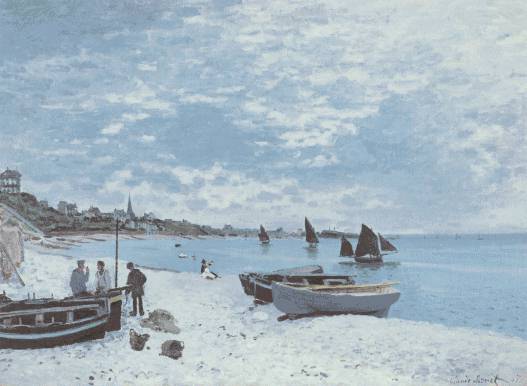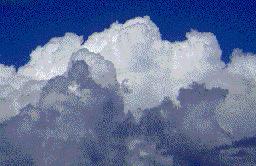 |
 |
| Home | Welcome | What's New | Site Map | Glossary | Weather Doctor Amazon Store | Book Store | Accolades | Email Us |
 | |||||||||||||||||||||||||||
Weather Almanac for May 1999A SPRINGTIME CLOUD-WATCHING KIND OF A DAYThis morning as I sat myself down to work on this month's additions to the Weather Doctor, the sky is predominantly clear, only scattered wisps of cloud decorate the sky vault like a haiku written in Japanese characters. I have chosen for this month's almanac cloud watching, for to me, May is a great month for that pastime. You see, by May the major storm tracks have moved into the Canadian North and large cyclonic storm systems with expansive cloud decks are infrequent visitors to most regions. Stratiform clouds give the stage to the cirrus and cumulus families. And the warm air and warmer sun provide excellent breeding grounds for towering cumuli. Such weather also gives wonderful training days for those lazy days of summer just over the horizon when cloud-watching and hammocks go together so naturally. Interacting with the full spectrum of sunlight and influences of dust and water, wind and terrain, clouds provide an infinite variety of shapes and colour to fuel the imagination, the sense of wonder and beauty, and at times, a sense of dread. Clouds too have been an inspiration to all forms of the arts. Clouds have been celebrated in verse:  And in song: The great masters have painted the many moods of clouds, both as the prime subject and as purposeful backdrop. Among the best are the works of Caspar David Friedrich, John Constable, Winslow Homer, Claude Monet, Rembrandt, Vincent van Gogh and J.M.W. Turner.  Beach at Sainte-Adresse (1867) by Claude MonetEven the great composers have composed sound poems about the clouds. Among my favorites are:
Several of these depict the cumulonimbus or thundercloud, the most vocal of the clouds. Surprisingly, clouds were long considered too ephemeral -- appearing, disappearing, always changing form -- to be classified into categories of common traits. That was be changed early in the Nineteenth Century by two amateur meteorologists. The famous French naturalist Jean Baptiste Lamarck published in early 1802 the first classification for certain forms of clouds. His classes were: hazy clouds, massed clouds, dappled clouds, broom-like clouds and grouped clouds. Later that year or early in 1803 (the exact date is unknown), British pharmacist Luke Howard presented a paper: "The Modification of Clouds" to the Askesian Society that proposed four main classes: cumulus, stratus, nimbus and cirrus. Nearly two centuries later, we still use those terms to describe those floating aerial masses of minute water droplets and ice crystals. Howard's four types have been combined with the cloud's altitude to give the ten main cloud classes that are today recognized by the World Meteorological Organization. Clouds are composed of billions and billions of microscopic droplets of water and/or crystals of ice only a few micrometres across. Each droplet, each crystal, forms on a small speck of matter -- a dust mote, a salt particle, a pollen grain, a smoke particle, etc. Despite their small size, those droplets/crystals may reflect, refract, scatter, diffract and absorb sun and moon light, providing a myriad of visual delights. And when the droplets/crystals congregate into bodies too large for the air to uphold, they fall as raindrops and snowflakes. Ah, the variety of images clouds bring to my mind. Sit back for a moment and think about those cloud images that reside in your memories. Do they include:  Brilliant altocumulus bands and ripples of salmon and gold, crimson and fiery orange, changing colour by the minute? Towering cumulus castles, bubbling and boiling, spearing the ground and nearby clouds with forks of lightning? Dense fog in which the world beyond a few metres distance disappears from view? Uniform stratus sheets which on closer inspection reveal subtle shadings of greys and blues?  Cotton bolls and cauliflower fringes on the horizon? A line of angry dark storm clouds invading the day like a panzer division on battle march, fixing to spoil a lazy, hazy day of summer? Wind-torn scud rags fluttering grey, white and blue? High wispy mare's tails and icy feather cirrus?  A prairie of wooly cumulus sheep grazing across the sky? A cold cloud pregnant with white, preparing to litter the landscape in snow? Banners and bunting of white fuzz draped over the mountains and hills? Those are among my most vivid cloud memories. As I write these words from the sun porch of my portable office, the cloud population of the sky above me explodes. What began as a clear morning has become a chaotic weather day, for above at least three layers of clouds now roam the sky. 
Almost hidden by the lower species, cirrus wisps ice the top of the multi-layered sky cake. Intermediate a layer of alto is filled with stratus and chunks of cumuli. In the lowest layer stands, or should I say roams, flocks of cumuli -- some silver wool, others a rainbow of grey with stringy virgae and rain showers trailing beneath. Most interesting today is the clutch of cumuli directly east, playing among the San Juan island group. Rain showers smudged by the winds give these clouds a soft, blended appearance to both their outline and colour -- a smear of grey with hints of blue. Off to my right, in contrast, the cumuli are silvery cauliflower heads lit from above by the noonday sun beams, which break through the alto and cirrus ceilings. Many seem to belong to the congestus cultivar of cumulus clouds today rather than the more common humilis variety. No doubt today is a sky watcher's paradise presenting more rings than a Barnum and Bailey circus to the delight of the spectator. Do you have Weather Eyes for a late spring day? If so, enjoy your May cloud buffet. Learn More From These Relevant Books
|
|||||||||||||||||||||||||||
 |
To Purchase Notecard, |
Now Available! Order Today! | |
 |
 |
NEW! Now |
The BC Weather Book: |


